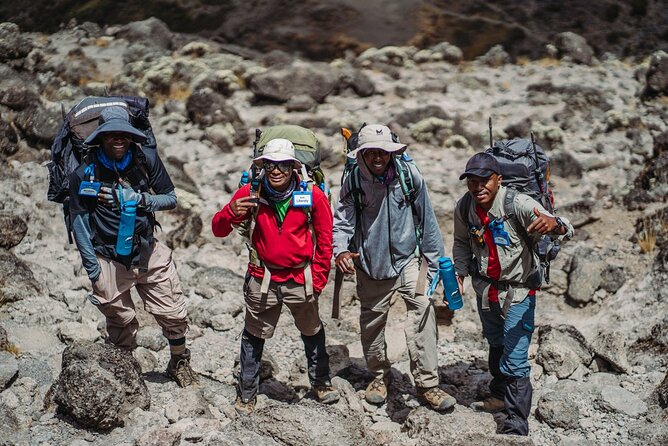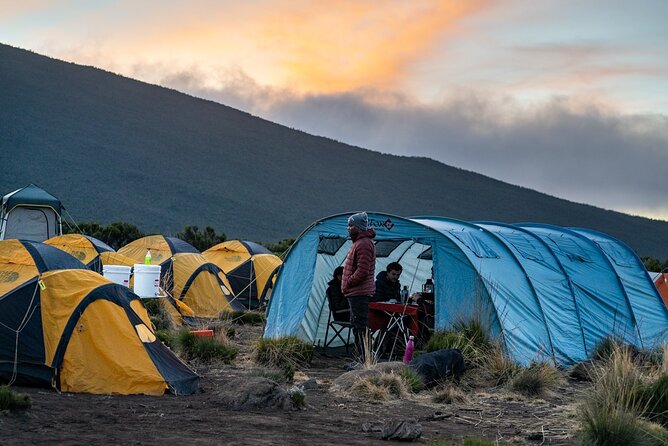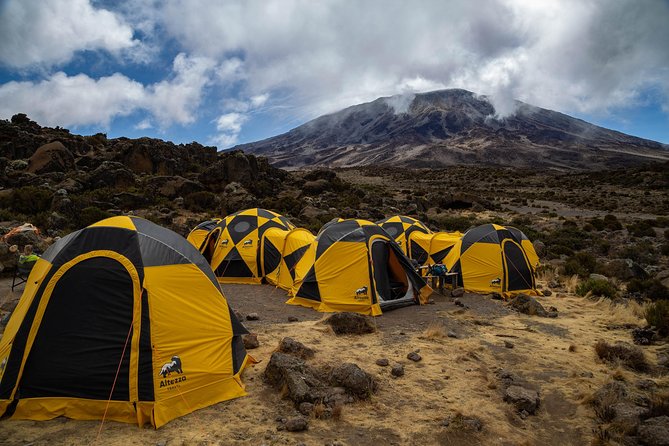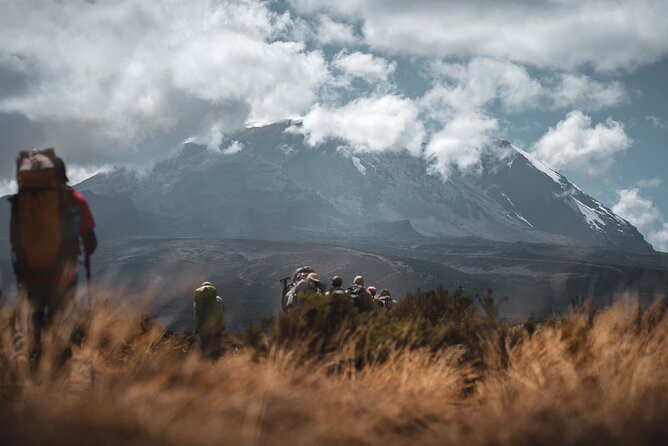Embarking on the Lemosho Route to the summit of Kilimanjaro is a captivating journey that rewards climbers with stunning vistas and a true sense of achievement. This 7-day trek offers a gradual ascent, allowing trekkers to properly acclimatize to the high altitude. Along the way, they’ll traverse diverse landscapes, from lush rainforests to barren alpine regions, all while supported by experienced guides and porters. While preparation and fitness are crucial, the comprehensive equipment and amenities provided ensure a comfortable experience. With an opportunity to reach the highest freestanding mountain in the world, the Lemosho Route presents an enthralling challenge for adventurous spirits.
Key Points

- The Lemosho route offers a gradual ascent with diverse climatic zones, from lush montane forests to alpine desert, for proper acclimatization and stunning landscapes.
- Experienced, certified guides monitor the group’s progress and make necessary adjustments, ensuring safety and reducing risks of altitude-related issues.
- Comprehensive group equipment, including dining tents, sleeping pads, and catered meals, provides comfort and caters to dietary needs throughout the trek.
- Participants must have a moderate level of physical fitness, no serious medical conditions, and no back problems that may be exacerbated by the trek.
- The cancellation policy ensures effective planning and logistics, with a full refund for cancellations up to 24 hours before the start of the trek.
Exploring the Lemosho Route

Ascending up through the diverse climatic zones of Mount Kilimanjaro, the Lemosho Route offers a captivating and comprehensive trek to the summit.
This less-crowded path winds its way through a stunning array of landscapes, from the lush montane forests at the base to the otherworldly alpine desert near Uhuru Peak.
Hikers will traverse several vegetation belts, including the heather-covered moorlands and the rocky, barren landscapes of the upper mountain.
The gradual ascent allows for proper acclimatization, reducing the risk of altitude sickness.
With its varied terrain and gradual incline, the Lemosho Route provides an exhilarating and scenic journey to the rooftop of Africa.
You can also read our reviews of more tours and experiences in Moshi.
Acclimatization and Altitude Considerations

Proper acclimatization is crucial when climbing Mount Kilimanjaro, as the ascent takes hikers through rapidly changing elevations and dramatically low oxygen levels.
To ensure a safe and successful summit, the following considerations are essential:
-
Slow ascent: Climbing slowly, with a maximum elevation gain of 300-400 meters per day, allows the body to adapt gradually to the decreasing oxygen levels.
-
Hydration and nutrition: Drinking plenty of water and consuming a high-calorie diet help the body cope with the physical demands of the climb.
-
Rest and sleep: Allowing for adequate rest and sleep periods helps the body recover and adjust to the changing environment.
-
Monitoring health: Regular medical checks, including oxygen level monitoring, help guide the pace and identify any altitude-related issues early on.
Diverse Climatic Zones

The Lemosho Route on Mount Kilimanjaro traverses a remarkable diversity of climatic zones, transporting hikers through an Arctic desert, alpine meadows, and lush rainforests before reaching the glacial summit. Trekkers will experience a dramatic shift in temperature, vegetation, and wildlife as they ascend the mountain. The table below showcases the different climatic zones encountered along the Lemosho Route:
| Zone | Elevation (m) | Climate | Vegetation |
|---|---|---|---|
| Arctic Desert | 4,600 – 5,895 | Freezing temperatures, high winds | Sparse, hardy plants |
| Alpine | 3,800 – 4,600 | Cold, with occasional snow | Grasses, shrubs, lichens |
| Moorland | 3,000 – 3,800 | Cool, with occasional rain | Heather, shrubs, small trees |
| Rainforest | 1,800 – 3,000 | Warm, humid, with heavy rainfall | Diverse, lush vegetation |
| Cultivated | 800 – 1,800 | Moderate temperatures, occasional rain | Farms, plantations |
This diversity of ecosystems makes the Lemosho Route a truly remarkable and captivating journey.
Group Equipment and Amenities

The Kilimanjaro climb by Lemosho Route provides a range of group equipment and amenities to ensure the comfort and convenience of trekkers.
Hikers will have access to a dining tent, sleeping pads, tables, chairs, crockery, and cutlery during their journey. Plus, the package includes three meals per day, as well as a variety of beverages such as tea, coffee, juices, and soda, catering to different dietary needs.
The group equipment includes:
- Dining tent for communal meals
- Sleeping pads to provide comfort on the trail
- Tables and chairs for dining and relaxation
- Comprehensive cooking and eating utensils
These amenities, coupled with the experienced guides and crew, contribute to an enjoyable and well-supported Kilimanjaro adventure.
Guides, Porters, and Crew

Experienced and certified Wilderness First Responder guides lead the Kilimanjaro climb, ensuring the safety and well-being of trekkers throughout the journey.
These guides are experts in mountain terrain and weather conditions, and they’ll share their extensive knowledge of the local flora and fauna.
They’ll monitor the group’s progress, provide encouragement, and make any necessary adjustments to the itinerary.
Porters and camp masters carry the equipment and set up camp, allowing climbers to focus on the trek.
The camp crew, including cooks, will prepare delicious and nourishing meals, catering to various dietary requirements.
Together, this experienced team works seamlessly to make the Kilimanjaro adventure a truly memorable experience for all participants.
Packing and Personal Gear

Preparing the right personal gear is key to a successful Kilimanjaro climb. Climbers should pack lightweight, moisture-wicking clothing that can withstand the changing weather conditions on the mountain. A high-quality hiking backpack, sturdy boots, and reliable trekking poles are essential for navigating the varied terrain. Layering clothing is recommended to stay warm and comfortable throughout the journey.
The essential personal gear for a Kilimanjaro trek includes:
- A warm sleeping bag rated for at least -10°C (14°F)
- A headlamp with extra batteries
- Sun protection (sunscreen, hat, sunglasses)
- A water bottle or hydration system
Cancellation and Refund Policy

Travelers can receive a full refund if they cancel their Kilimanjaro climb up to 24 hours before the experience start time. However, no refund is provided for cancellations made less than 24 hours prior, and any changes requested within 24 hours of the start time won’t be accepted.
This cancellation policy is in place to ensure the operator can effectively plan and execute the logistics of the expedition. It’s essential for travelers to be aware of these terms before booking, as the remote location and limited availability make late cancellations challenging to accommodate.
Suitability and Fitness Requirements

The Kilimanjaro climb by the Lemosho Route isn’t suitable for everyone. Travelers with certain medical conditions or physical limitations should refrain from attempting this strenuous hike.
To ensure a safe and enjoyable experience, the following requirements must be met:
Moderate physical fitness level: The trek involves long hours of hiking, ascending steep terrain, and carrying personal gear, which requires a good level of cardiovascular endurance and muscular strength.
No serious medical conditions: Individuals with heart problems, respiratory issues, or other serious ailments may not be able to handle the high altitude and physical demands of the climb.
No pregnancy: Pregnant women are advised not to attempt the Kilimanjaro climb due to the health risks associated with high altitudes.
No back problems: Hikers with pre-existing back conditions may find the trek especially challenging and should consult a medical professional before booking.
Frequently Asked Questions
What Is the Maximum Group Size for This Tour?
The maximum group size for this tour is not explicitly stated. The tour is described as a "private tour, only your group will participate", suggesting a flexible group size tailored to the client’s preferences.
Can I Bring My Own Food and Snacks on the Hike?
Hikers are generally allowed to bring their own food and snacks on the hike, as long as they don’t interfere with the group meals provided. However, it’s best to check with the tour operator for any specific guidelines or restrictions.
Is It Possible to Hire Porters for Personal Gear?
Yes, it’s possible to hire porters to carry your personal gear on the hike. Many tour operators offer this service, which allows hikers to focus on the trek without having to carry heavy loads themselves.
Can I Upgrade to a Private Tent on the Mountain?
Yes, you can upgrade to a private tent on the mountain. This provides more privacy and personal space during your trek. There’s typically an additional charge for this upgrade, which should be arranged with the tour operator in advance.
What Is the Cancellation Policy for This Tour?
The cancellation policy allows for a full refund if cancelled at least 24 hours before the tour starts. Cancellations less than 24 hours before the tour have no refund, and changes within 24 hours are not accepted.
Recap
The Lemosho route on Kilimanjaro offers a comprehensive and well-supported journey to the roof of Africa.
Hikers can expect stunning landscapes, gradual acclimatization, and comfortable amenities provided by experienced guides and porters.
Proper preparation is essential, but this route caters to various fitness levels and dietary needs, ensuring an exhilarating climb to the summit.
More Tour Reviews in Moshi
- Private Tour to Materuni Waterfalls, Coffee Tour, Kikuletwa Hot Springs & Maasai
- 7-day Best of Tanzania Lodge Safari
- 4 Days Wildlife Tanzania Adventure
- Affordable Short Tanzania Safari (2 Days Camping Safari)
- 6 Days Mount Kilimanjaro Climbing via Rongai Route
- 8 Days Tanzania Adventure Tented Camps Safari
Not for you? Here's more things to do in Moshi we have recnetly reviewed
- 7 Best 3 Day Tours In Moshi
- 14 Best 4 Day Tours In Moshi
- 2 Best Private Car With Driver Services In Livingstone
- 4 Best Private Car With Driver Services In Moshi
- 15 Best Coffee Tours And Tastings In Moshi
- Marangu Route 6 Days 5 Nights/Kilimanjaro Climb
- Private 5-Days Serengeti Trails With Kojuu Safaris
- Full Day Private Safari – Tarangire National Park
- 9 Days 8 Nights Walking Safari
- Mt Kilimanjaro Climbing; 6 Days Machame Route
- Kilimanjaro Climb – 6 Days Marangu Route
- 5 Days African Safaris
